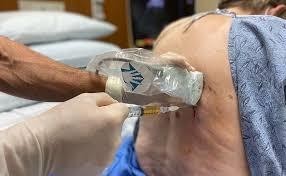The nurse is caring for a client after a thoracentesis that drained 50 mL of clear fluid from the left lung. Which assessment finding should the nurse report to the healthcare provider immediately?
Dullness bilaterally on percussion.
Serosanguinous drainage from the chest tube.
Diminished breath sounds in the left lower lobe.
Mediastinal shift to the right.
The Correct Answer is D
A) Incorrect- Dullness bilaterally on percussion is not a normal finding, but it is not an immediate concern after thoracentesis. It may indicate fluid accumulation or consolidation in both lungs, which could be related to other conditions such as pneumonia or heart failure.
B) Incorrect- Serosanguinous drainage from the chest tube is expected after thoracentesis, as long as it is not excessive or continuous. The nurse should monitor the amount and color of the drainage and document it accordingly.
C) Incorrect- Diminished breath sounds in the left lower lobe are also expected after thoracentesis, as the procedure removes fluid and air from the pleural space and reduces lung expansion. The nurse should auscultate the lungs before and after the procedure and compare the findings. The breath sounds should improve gradually as the lung re-expands.
D) Correct- This is a sign of tension pneumothorax, which is a life-threatening complication of thoracentesis. Tension pneumothorax occurs when air accumulates in the pleural space and creates positive pressure that pushes the mediastinum (the heart, great vessels, and trachea) to the opposite side of the chest. This can impair venous return, cardiac output, and respiratory function. The nurse should report this finding to the healthcare provider immediately and prepare to assist with needle decompression or chest tube insertion.

Nursing Test Bank
Naxlex Comprehensive Predictor Exams
Related Questions
Correct Answer is ["A","B","C","D","E"]
Explanation
It is important to assess the child's vital signs, including oxygen saturation (SaO2), to ensure their stability and identify any signs of respiratory distress or other abnormalities that may impact medication administration.
Prior to administering any medication, it is crucial to verify if the child has any known allergies to medications. This information is essential for ensuring the safety of the child and preventing any potential allergic reactions.
Before administering pain medication, the nurse must verify that the prescribed dosage is appropriate for the child's age, weight, and condition. Ensuring the correct dosage helps prevent medication errors and potential adverse effects.
It is important to use a validated pain assessment tool that is appropriate for the child's age and cognitive abilities. This allows for a comprehensive and accurate assessment of the child's pain level, helping guide appropriate pain management interventions.
Considering the child has cognitive and speech delays, the input from the parent regarding the child's pain is valuable. The nurse should assess and consider the parent's report of the child's pain in conjunction with other assessment findings to ensure effective pain management.
Subjective pain assessment is mentioned as a finding but may not require immediate action, as it needs to be combined with other assessment data for a comprehensive evaluation.
Correct Answer is ["A","B","D"]
Explanation
A) Correct- Weighing the client and reporting any weight gain is a routine measurement that can be safely performed by the UAP. Weight gain can be an important indicator of fluid retention, a common issue in Cushing's syndrome.
B) Correct- Reporting any client complaints of pain or discomfort is important for monitoring the client's well-being and promptly addressing any potential issues.
C) Incorrect- Evaluating the client for sleep disturbances involves assessing the client's sleep patterns, quality, and potential disruptions. This requires nursing judgment and a deeper understanding of the client's condition and potential contributing factors, so it's not appropriate to delegate this task to the UAP.
D) Correct- Noting and reporting the client's food and liquid intake during meals and snacks is part of monitoring the client's nutritional status, which is an appropriate task for the UAP.
E) Incorrect- Assessing the client for weakness and fatigue involves a more comprehensive evaluation of the client's physical and physiological status, which requires nursing expertise. The nurse should directly assess and interpret these symptoms in the context of Cushing's syndrome to provide appropriate interventions.
Whether you are a student looking to ace your exams or a practicing nurse seeking to enhance your expertise , our nursing education contents will empower you with the confidence and competence to make a difference in the lives of patients and become a respected leader in the healthcare field.
Visit Naxlex, invest in your future and unlock endless possibilities with our unparalleled nursing education contents today
Report Wrong Answer on the Current Question
Do you disagree with the answer? If yes, what is your expected answer? Explain.
Kindly be descriptive with the issue you are facing.
